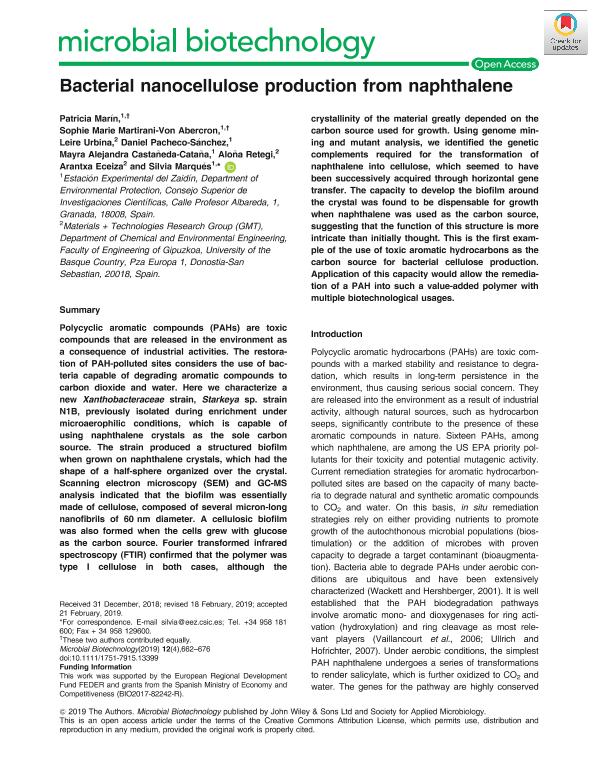Artículo
Bacterial nanocellulose production from naphthalene
Marín, Patricia; Martirani Von Abercron, Sophie Marie; Urbina, Leire; Pacheco Sánchez, Daniel; Castañeda Cataña, Mayra Alejandra ; Retegi, Aloña; Eceiza, Arantxa; Marqués, Silvia
; Retegi, Aloña; Eceiza, Arantxa; Marqués, Silvia
 ; Retegi, Aloña; Eceiza, Arantxa; Marqués, Silvia
; Retegi, Aloña; Eceiza, Arantxa; Marqués, Silvia
Fecha de publicación:
07/2019
Editorial:
John Wiley & Sons Ltd
Revista:
Microbial Biotechnology
ISSN:
1751-7907
e-ISSN:
1751-7915
Idioma:
Inglés
Tipo de recurso:
Artículo publicado
Clasificación temática:
Resumen
Polycyclic aromatic compounds (PAHs) are toxic compounds that are released in the environment as a consequence of industrial activities. The restoration of PAH-polluted sites considers the use of bacteria capable of degrading aromatic compounds to carbon dioxide and water. Here we characterize a new Xanthobacteraceae strain, Starkeya sp. strain N1B, previously isolated during enrichment under microaerophilic conditions, which is capable of using naphthalene crystals as the sole carbon source. The strain produced a structured biofilm when grown on naphthalene crystals, which had the shape of a half-sphere organized over the crystal. Scanning electron microscopy (SEM) and GC-MS analysis indicated that the biofilm was essentially made of cellulose, composed of several micron-long nanofibrils of 60 nm diameter. A cellulosic biofilm was also formed when the cells grew with glucose as the carbon source. Fourier transformed infrared spectroscopy (FTIR) confirmed that the polymer was type I cellulose in both cases, although the crystallinity of the material greatly depended on the carbon source used for growth. Using genome mining and mutant analysis, we identified the genetic complements required for the transformation of naphthalene into cellulose, which seemed to have been successively acquired through horizontal gene transfer. The capacity to develop the biofilm around the crystal was found to be dispensable for growth when naphthalene was used as the carbon source, suggesting that the function of this structure is more intricate than initially thought. This is the first example of the use of toxic aromatic hydrocarbons as the carbon source for bacterial cellulose production. Application of this capacity would allow the remediation of a PAH into such a value-added polymer with multiple biotechnological usages.
Archivos asociados
Licencia
Identificadores
Colecciones
Articulos(IQUIBICEN)
Articulos de INSTITUTO DE QUIMICA BIOLOGICA DE LA FACULTAD DE CS. EXACTAS Y NATURALES
Articulos de INSTITUTO DE QUIMICA BIOLOGICA DE LA FACULTAD DE CS. EXACTAS Y NATURALES
Citación
Marín, Patricia; Martirani Von Abercron, Sophie Marie; Urbina, Leire; Pacheco Sánchez, Daniel; Castañeda Cataña, Mayra Alejandra; et al.; Bacterial nanocellulose production from naphthalene; John Wiley & Sons Ltd; Microbial Biotechnology; 12; 4; 7-2019; 662-676
Compartir
Altmétricas



